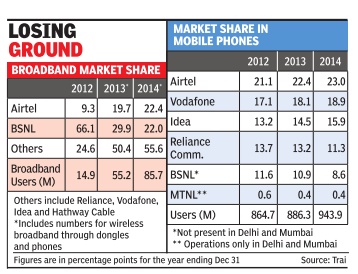Telecommunications, India: 1
(→‘Call drops’) |
(→2017/ Market controlled by local heavyweights) |
||
| Line 232: | Line 232: | ||
“Don't expect any reduction in the market competition in medium term, as large telcos would continue to keep the intensity high. However, in the long term this consolidation would restore some pricing power and give better bargaining terms with vendors and suppliers.The industry will be left with five major players namely -Vodafone-Idea, Bharti Airtel, Reliance Jio, RCom-Aircel-Sistema and BSNL plus MTNL,“ Harsh Jagnani, VP, sector head, Icra, said. | “Don't expect any reduction in the market competition in medium term, as large telcos would continue to keep the intensity high. However, in the long term this consolidation would restore some pricing power and give better bargaining terms with vendors and suppliers.The industry will be left with five major players namely -Vodafone-Idea, Bharti Airtel, Reliance Jio, RCom-Aircel-Sistema and BSNL plus MTNL,“ Harsh Jagnani, VP, sector head, Icra, said. | ||
| + | |||
| + | ==2017: Indians get most spam in the world== | ||
| + | |||
| + | [http://epaperbeta.timesofindia.com/Article.aspx?eid=31808&articlexml=Indians-get-most-spam-calls-in-the-world-16072017001062 Himanshi Dhawan|Indians get most spam calls in the world|Jul 16 2017 : The Times of India (Delhi)] | ||
| + | |||
| + | You're not imagining it. | ||
| + | Spam calls are on the ri se. A study of 20 count ries has revealed that Indians received the most number of spam calls in 2017. | ||
| + | |||
| + | Research by Truecaller, an app which has over 250 mil lion users globally , showed that an Indian smartphone user received over 22 spam calls a month, or almost a call a day. The US and Brazil came in second with over 20 calls per user each month. | ||
| + | |||
| + | The report says that over half of India's spam calls (54%) originate from telecom operators. “Many of these operators are seeking to provide special offers for free data, or unlimited calls. Which doesn't sound so bad, until you get bombarded by them.“ | ||
| + | |||
| + | Nuisance calls -including unwanted, harassment and pranks -stake claim to 20% of the calls. Among the other spam calls Indians receive are 13% from telemarke ters, 9% from financial services while 3% are related to insurance and scams. | ||
| + | |||
| + | This is despite the fact that India's regulatory system includes a do-not-disturb (DND) registry as well as an unsolicited commercial communication regulation. Other countries are not much better off either. Unwanted calls to Americans have risen sharply by 20% in the last two months. Telecom operators are the top spammers (33%) in Brazil, with calls seeking to provide special offers for data and calling plans. The second biggest spammers in Brazil are debt collectors, though sometimes these calls can be fraudsters pretending to collect money for illegitimate reasons. | ||
| + | |||
| + | Chile, South Africa and Mexico are next among spam-plagued countries. The data for the report was aggregated anonymously from incoming calls that were either marked as spam by users or had automatically been flagged by Truecaller. | ||
==Market share, subscribers, profit-loss-debt== | ==Market share, subscribers, profit-loss-debt== | ||
Revision as of 12:16, 3 October 2017
This is a collection of articles archived for the excellence of their content. |
CAG report: 2006-10



The Times of India, Mar 12, 2016
CAG: 6 telcos understated revenue by Rs 46,000 crore, govt lost Rs 12,490 crore
A Comptroller and Auditor General (CAG) report on the accounts of six private telecom operators, tabled in Parliament, blamed the department of telecom for the lack of monitoring that resulted in companies adopting "ingenious methods" to understate revenue by over Rs 46,000 crore, which resulted in a loss of around Rs 12,490 crore to the government. The auditor — as reported by TOI on March 9 — examined the accounts of six operators — Airtel, Tata, Reliance, Idea, Vodafone and Aircel — between 2006-07 and 2009-10, and found that Tata group and Reliance Communications were among the top defaulters, followed by Bharti Airtel. The three together caused a loss of Rs 10,000 crore to the exchequer. The CAG had been prevented from auditing these private service providers since 2009 after they moved different courts challenging its mandate. However, after the Supreme Court settled the issue in favour of CAG by an order of April 2014, these companies were compelled to share their accounts for inspection. During the period from when the accounts were examined, the private operators were in a revenue sharing arrangement with the government.
After a few years of reporting all income, some of these operators started shifting their profit to subsidiaries created for this purpose or adopting other measures to understate revenue. According to the CAG, Reliance Communications Ltd (RCL) understated revenue by over Rs 4,400 crore by entering into a separate arrangement with subsidiary Reliance Communications Infrastructure Ltd, and shifting all revenue on account of value added services into the accounts of RCIL instead of RCL, thus denying the government its share of Rs 520 crore during the period. "The government was deprived of a total revenue of Rs 12,488.93 crore on account of non-payment of licence fee of Rs 3,752 crore, spectrum usage charges of Rs 1,460 crore and interest of Rs 7,276 crore due from the six companies," CAG said.
The auditor said proper monitoring of Controller of Communication Accounts was required and the "DoT also needs to strengthen its internal audit mechanism to ensure that verification of deductions is checked regularly". The telecom firms had also not taken into account their income from interest, foreign exchange etc. "The companies were also reducing their revenues by adjusting bad debts," the CAG said, adding that infrastructure sharing revenue was an example of concealing revenue by recording it as reduction of expenditure.
"Another area for suppressing the revenues was transfer of assets by telecom companies to their subsidiaries at a value lower than market value or at nil value," a senior CAG official said. Companies were also found indulging in providing interest free loans to their subsidiaries.
‘Call drops’
From the Archives of ‘‘The Times of India’’: 2008
A year after the “do-notcall registry” got under way, nearly 8.3m cellphone users have registered
Yet pesky calls continue. It’s time to launch a new registry of people who wish to receive commercial calls, says the Supreme Court
Govt says it is difficult to take action against telemarketers not registered with DoT
SC asks govt to bar unregistered telemarketers from operating
2016: No cellular operator meets call-drop cutoff
The Times of India, June 2, 2016
Pankaj Doval
A survey conducted by telecom regulator Trai between May 3 and May 6 has pointed out that nearly all operators in the national capital have call drops beyond the stipulated benchmark of 2% of all calls. This finding of a 12city survey (results for the other cities will be released soon) comes amid protests by telcos against imposition of any penalty for call drops.They have even earned a reprieve from the apex court in this regard. Bharti Airtel, the leading company , saw a deterioration in services when its performance was compared to a similar survey conducted in January . The call drop rate rose to 3.3% on the 2G network (1.4% in January) and 2.2% on 3G (1.6%). Airtel claims it is working towards a voluntary benchmark of 1.5% to impro ve its services beyond Trai's mandate.
Close-rival Vodafone had a 2.8% call drop rate on its 2G network, though this came down from the 3.9% in the previous round. However, Vodafone's 3G was found to be well within the prescribed limits.
Idea Cellular, the third-largest company operating in the city, fared miserably on its 3G network with a rate of 6.2%.Calls on the 2G network were under the set limit.
“There has definitely been a degradation in quality of performance when it comes to call drops,“ Trai chairman RS Sharma said.
The Cellular Operators Association of India has in the past raised questions on the results of the surveys conducted by Trai. The operators, who blame the poor service to lack of permission to install additional cellular towers, have also questioned the manner in which the tests have been conducted by Trai. Officials of the telecom regulator now say they are looking at ways to fix accountability on the operators as their move to impose a penalty was not allowed by the apex court.
“We will come out with some remedial measures very soon,“ said Anil Kaushal, a member of Trai. The regulator will also write to the telecom ministry regarding some proposals that will give it teeth to impose financial penalties, Trai secretary Sudhir Gupta said. Telecom minister Ravi Shankar Prasad, who has been vocal about the need for improved telecom services, has already said the government will consider amendments to the Act governing Trai in order to give it penal powers.
The survey showed that state-run MTNL's network is in very poor condition. Call drops on MTNL's 2G network were at an extreme 10.4% while it was 8.2% on 3G. Anil Ambani's RCom had a poor 5.2% call drop rate on its 3G network, though it was at 1.4% on the 2G network.
Many independent analysts have said telcos are not ready to make requisite investments in upgrading their alreadychoked infrastructure, and this is one of the main reasons behind the poor services. Most of the telcos have, however, disagreed with the comments.
Inter-connect usage charges
30p in 2004> 6p in 2017

Mobile phone bills are set to come down further with the Telecom Regulatory Authority of India announcing a steep cut in charges that phone companies pay each other for connecting calls. Trai on Tuesday cut the inter-connect usage charges (IUC) to 6 paise per minute from 14 paise. While the new charges come into effect from October, the regulator has laid the roadmap to do away with the IUC altogether from January 1, 2020. TOI was the first to report on the impending IUC cut in its edition dated August 13.
“It has been observed that reducing termination rates (IUC) has benefited consumers and enhanced competition... The reduction in the mobile termination charge is likely to yield consumer benefits,“ Trai said. Older telecom operators such as Bharti Airtel, Vodafone and Idea Cellular have opposed cutting IUC and instead asked for it to be raised.
Legal aspects/ Superior court judgements
Call registry/ do-not-call registry
SC reflects Times View on pesky calls
Suggests ‘Call Me’ Registry
Dhananjay Mahapatra | TNN From the Archives of ‘‘The Times of India’’: 2008
New Delhi: Those pesky calls may finally dry up. Reacting to a common complaint of millions, the Supreme Court on Thursday maintained that the year-old National Do-Not-Call Registry (NDNCR) has just not worked as telemarketers have continued to breach the citizen’s right to privacy, and suggested that NDNRC should be replaced by a “call registry” — that is, those wishing to receive telemarketers’ calls should register themselves for the purpose.
Remarkably, a little over eight months ago, this newspaper in its Times View had made precisely this suggestion. On the front page on November 18, 2007, we had said, ‘‘There’s a better way out of this mess than trying to make the do-not-call registry work — have a “call registry” instead. In other words, the default option should be that telemarketers cannot make unsolicited calls. Those who wish to receive calls can register themselves on the call register.’’
In response to the suggestion of a bench comprising Justices A K Mathur and Dalveer Bhandari, additional solicitor general Gopal Subramaniam said the Centre would consider it in all seriousness and get back to the court within six weeks. Subramaniam appeared to have been impressed by the suggestion, which he termed as ‘‘weighty’’.
On the issue of pesky calls, the SC has not just been concerned but proactive. Last year it had virtually forced the government to operationalize the “do-not-call registry” while dealing with a PIL filed by one Harsh Pathak accusing service providers of selling their data base to telemarketers who made unsolicited calls.
“In the last one year, we have experienced such calls galore. At least we are victims of it. A year back, you (the Centre) were not willing to implement the regulations. They were implemented after we threatened to do it through our order. After one year, we feel something more needs to be done,” the court said.
Privacy: right is primary, SC
From the Archives of ‘‘The Times of India’’: 2008
New Delhi: The SC on Thursday maintained that the yearold ‘National Do-Not-Call Registry’ (NDNCR) has just not worked as telemarketers have continued to breach the citizen’s right to privacy.
‘‘It is time to rechristen the ‘Do-Not-Call Registry’ as ‘Call Receivers Registry’,’’ said the court and explained that those who registered in the latter would only be entitled to receive calls from telemarketers. “Persons interested in commercial calls must volunteer and get registered. Those who do not wish to register should not be disturbed,” it said.
Additional solicitor-general Gopal Subramaniam said the government was finding it difficult to take action against many telemarketers, who were not registered with the telecom department and continued to escape the rigours of the rule banning unsolicited commercial calls. On this, the SC directed the government to stop the operations of unregistered telemarketers right away. When the government informed the court that till date, nearly 8.3 million mobile phone subscribers have registered in NDNCR, it wondered how could these pesky calls be still so rampant and bother so many people.
Subramaniam said the government has control over registered telemarketers, who come under the purview of penal regulations for making unsolicited calls. So it was imperative that no telemarketer be allowed to operate unless it is registered, he said. Considering the impact of the SC’s views on their marketing strategy, banks and service providers were adequately represented before the court. Their counsel, senior advocates T R Andhyarjuna and C S Vaidyanathan, informed the SC that the position was not as bad as was being projected. Till date, about 13,600 telemarketing operators have registered with the government, they said. They relied on figures to argue that through telemarketing, a lot of business has come to people.
The court disagreed and asked: “For your business, do we have to suffer?” Vaidyanathan joined issue and said imposing a total ban on telemarketing would be at cross with the constitutional provision. But the SC rejected the argument, saying right to privacy always gets primacy.

2013
Chennai second among metros in mobile subscriber growth
Ishan Srivastava, TNN | Aug 27, 2013 The Times of India
CHENNAI added 82,296 mobile subscribers in July 2013, the second highest among four metros, according to the latest data released by Telecom Regulatory Authority of India (Trai). With this addition, total number of subscribers in Chennai has reached 1.15 crore. As per the 2011 census, Chennai has a population of 46 lakh.
Chennai's growth is second only to Delhi in that month, which added four lakh users on a subscriber base of 2.8 crore. Mumbai follows Chennai with 81,738 additions and Kolkata added 39,946 to its subscriber base.
Teledensity -- the number of mobile connections relative to population --crossed the 100% mark for the metros in 2009, implying that there were more mobile connections in these cities than the number of residents. The current teledensity in Chennai is nearly 200% or two mobile connections for every person, but the growth shows no signs of slowing down with constant monthly additions. For example, Chennai added 83,290 users in June and 70,444 in May.
Multi-SIM usage, increased migrant population and data consumption are seen as the main reasons driving growth. "A lot of these additions are 'passive' SIMs that people keep just to avail of offers or to enjoy better rates on particular routes and are not in regular use," said Sandip Biswas, director at Deloitte, a consultancy firm. "Operators don't mind it either and are happy with any increase in numbers in such a highly competitive market."
Also, a lot of usage of new SIMs is driven by data consumption where people buy SIMs to access internet on their media devices such as tablets in addition to the one they use for voice, said Milan Sheth, partner at consultancy firm EY.
However, some experts said that subscriber numbers have become less relevant now and what matters is how much data is being consumed by people and how much money is realised by telecom companies through it. "Inactive connections can be as high as 20%-30 % of total ," said Prashant Singhal, partner at EY and who tracks telecom sector.
Feb 14 2015

Pankaj Doval
BSNL's share in mobile biz dips to single digit
Edged out by Airtel in broadband market
Jayanta Kumar was a harried customer of BSNL. A resident of Ghaziabad in the National Capital Region, he had been running from pillar to post just to get a bill for his landline and broadband connection, which was not delivered for six months.“Finally , I had to use my contacts to prompt them in generating a bill. Is this how you do business?“ says Kumar, who discontinued his BSNL connection and hopped on to a private operator. It's a sorry state of affairs at the telecom PSU that once was the backbone of the country's telecom infrastructure.The company has been in losses for the last many years. It appears to be stuck in a time warp as failure to keep pace with the highly competitive private operators and a general lackluster attitude of ground-level and managerial staff has seen its share in mobile subscribers narrow down to single digit, while Bharti Airtel has moved ahead and gained the top spot in broadband, according to numbers released by regulator Trai.
BSNL's share in the mobile phone market came down to 8.6% in 2014 against 11.6% in 2012. This happened even when the overall mobile subscriber base had grown from nearly 865 million in 2012 to 944 million at the end of last year.BSNL had losses of around Rs 7,000 crore in 2013-14.
BSNL old-timers blame the flight of customers to private players due to poor network quality brought on by delays in procurement of equipment. While BSNL's current CMD Anupam Shrivastava is hopeful of a turnaround on the back of a “renewed focus“ after the entry of the Modi government, not everyone is happy with the present situation.
R K Upadhyay , former CMD of BSNL, said he is surprised by the fall in the com pany's market share as most of the network expansion had been done. “We have network capacity and coverage to support growth. So, it is difficult to justify the fall in numbers,“ he told TOI.
Asked about the poor lastmile services, he did concede that the attitude of groundlevel and managerial staff needs to change. “There is a PSU hangover, and I cannot deny this. However, unlike the private operators, we cannot outsource our functions.With technology advancement, some of our existing staff may not be relevant today , but we cannot abandon them. They need to be paid till they serve.”
2014: An increasing use of data than voice calls
November 24, 2014
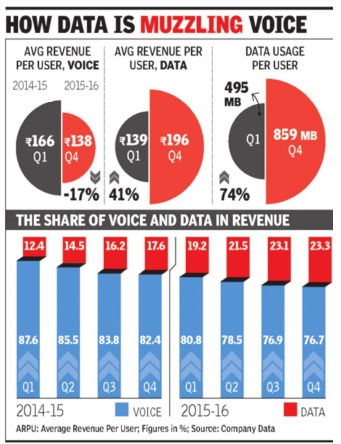

A Newsflicks study of the latest mobile phone user and revenue trends reveals we are talking more through data than voice.
RCom, Aircel dial merger/ 2016
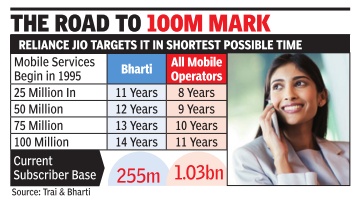
New Entity Will Have Revenues Of $4Bn, 180M Subscribers
In the biggest telecom merger in India, Reliance Communications (RCom) and Aircel have agreed to combine their wireless operations, creating the country's fourth biggest player with revenues of $4 billion and a subscriber base of 180 million, after Bharti Airtel, Vodafone and Idea Cellular.In terms of subscribers, Bharti Airtel led the pack in sept 2016 with 250 million customers followed by Vodafone (200 million) and Idea Cellular (175 million).
The merger assumes significance in the telecom market where an intense competition following the entry of Reliance Jio is expected to trigger consolidation. RCom and Aircel will hold an equal stake of 50% in the combined entity , which plans to have a new brand name for its mobile phone services.
The Anil Ambani-led RCom and Aircel, in which Malaysia's Maxis is the largest shareholder, had been in negotiations since December 2016.
Maxis said that the merger and the further equity support reinforces its commitment to India. Maxis had invested Rs 35,000 crore ($5.2 billion) in Aircel, which was one of the largest foreign investments into India. The other shareholders of Aircel are United Telecom (including Saudi Telecom) and the Reddy family of Apollo Hospitals. RCom said that the partners are in talks with leading international investors to raise capital for the merged entity. RCom had recently acquired Russian conglomerate Sistema's local unit, which operated under the MTS brand, and as part of the latest deal Sistema holds 10% stake in the company .
September 2016: Landline connections
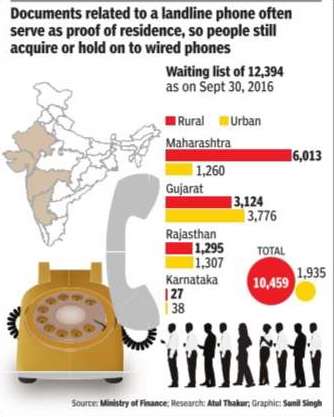
2017/ Vodafone- Idea merger: India’s no.1, world’s no.2
Partial retreat for Voda from losing mkt, sweet deal for Idea?, Mar 21 2017, The Times of India

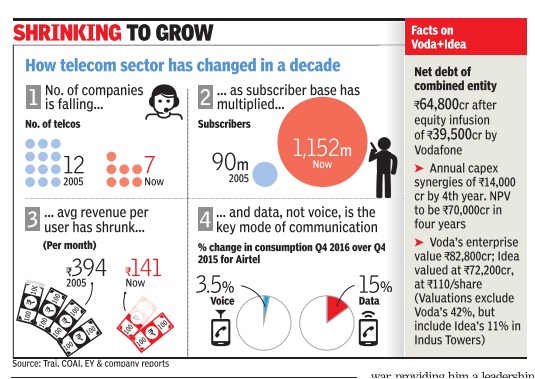

Combined Co To Be Global No 2 In Subscribers
London-headquartered Vodafone and Kumar Birla-controlled Idea Cellular on Monday announced India Inc's biggest-ever merger to create the country's undispu ted leader in the world's second largest telecom market after China. The combined 394 million subscriber base of India's second and third largest telcos will eclipse Bharti Airtel's 270 million -and catapult the merged company to No 2 spot globally. It could also alter the landscape of an in dustry that's facing cut-throat competition from Mukesh Ambani's recently-launched Reliance Jio.
TOI was the first to write, in its edition of January 28, that Vodafone and Idea were in advanced discussions for a merger (there had been some speculation last year, also re ported by TOI, but nothing had come of it at the time).
The mega-merger will create a company that will be No. 1 or a strong No. 2 in all telecom circles except Jammu & Kashmir. Voda's 204 million subscribers and Idea's 190 million (at the end of 2016) will give them a combined market share of 35%. Aggregate revenues of over Rs 80,000 crore represent 42% of the national pie.
Vodafone's global CEO Vit torio Colao told TOI in a joint interview with Birla that the consolidation was driven primarily by the “arrival of data, which is very capital heavy and consumes a lot of spectrum“ along with reasons like synergy and cost savings. Although Vodafone will hold 45% and Idea Cellu lar 26% stake in the postmerger company , which is being valued at $23 billion, they will have equal voting rights (again, TOI had reported on Jan 28 that Idea was pressing for it). The combine the name and brand identity of which will be decided in due course will be jointly managed with three representatives each on a 12-member board. Birla will take over as chairman of the new entity upon the completion of the deal in 2018. While the two sides will together decide on the CEO, Idea's Himanshu Kapania is expected to steer the combined operations; the choice of chief financial officer will be Vodafone’s.
The transaction gives Idea the option to buy 9.5% stake in the new company over the next four years at Rs 130 per share. If Birla chooses not to exercise the option, Vodafone will sell down shares to equalize its shareholding with Idea. On January 30, two days after the TOI report, Vodafone and Idea had confirmed they were in talks. On Monday , they maintained that the merger would not breach subscriber and spectrum threshold limits in a big way (only in five circles, according to telecom analysts) as reported by this newspaper on January 28.
Perhaps in a bid to bring about near-parity between the two, the merger excludes the Vodafone's 42% interest in Indus Towers while valuing the British telecom giant unlisted Indian subsidiary at $12.4 billion (Rs 82,000 crore), but includes Mumbai-listed Idea's 11% stake in Indus in its $10.8 billion (72,000 crore) valuation.Analysts viewed the deal making as a strategic retreat for Vodafone from a lossmaking market where it has written off $9 billion till date. Jio's freebies have pushed incumbents into a corner with Bharti Airtel, Vodafone and Idea posting quarterly losses.
In 2007, Vodafone stepped into Indian market when it paid Hutchison Whampoa $11 billion for controlling stake, and later coughed up another $5.5 billion to buy out the 33% held by the Ruias of Essar. Vodafone has since invested billions in multi ple rounds of spectrum auctions even as competition ate into pricing power in what was once hailed as one of the world's most promising telecom markets. Losses from the Indian business have weighed down Vodafone's global results in the recent past and prompted its CEO to consider `de-consolidation’.
The merger will also strengthen Birla's hand in a bruising war , providing him a leadership platform and a bigger balance sheet to take on rivals, including Jio. Idea shares have been beaten down until the merger speculation gained credence as it was considered to be the weakest among the top three to face the Jio onslaught. Idea shares gyrated wildly rising 15% in morning trade but subsequently declined10% indicating investor apathy with the deal construct. Both Vodafone and Idea played down the market volatility stating it would take markets “a while to digest details of a complex transaction“.
“For Idea shareholders and lenders who have supported us thus far, this transaction is highly accretive, and Idea and Vodafone will together create a very valuable company given our complementary strengths,“ Birla said. “The combined company will have the scale required to ensure sustainable consumer choice in a competitive market and to expand new technologies that have the potential to transform daily life,“ Colao added.
2017/ Market controlled by local heavyweights
India's Big Club helms telecom story , Mar 21, 2017: The Times of India
India's telecom market is firmly in control of local heavyweights -Kumar Mangalam Birla, Sunil Mittal and Mukesh Ambani -after foreign players retreat from a sector with over a billion subscribers.
Though Vodafone CEO Vittorio Colao emphasised the company wasn't exiting India, it was clearly “deconsolidating“ the troubled Indian business from its global footprint. Recent M&A deals have seen Norwe gian giant Telenor selling out to Bharti Airtel and Malaysian telco Aircel and Russian operator Sistema folding into Anil Ambani's Reliance Communications.
Japan's NTT DoCoMo decided to exit an under-perfor ming joint venture with Tata Teleservices, while Bahrain Telecommunications (Batelco) snapped ties with C Sivasankaran's S Tel and UAE's Etisalat exited the country after the spectrum auction scandal, which erupted six years ago.
Singapore Telecommunications (SingTel), remains a large but passive shareholder in Bharti Airtel. Then there were others like Australia's Telstra and South African major MTN calling off India plans, following the spectrum controversy and intense market competition.
“Don't expect any reduction in the market competition in medium term, as large telcos would continue to keep the intensity high. However, in the long term this consolidation would restore some pricing power and give better bargaining terms with vendors and suppliers.The industry will be left with five major players namely -Vodafone-Idea, Bharti Airtel, Reliance Jio, RCom-Aircel-Sistema and BSNL plus MTNL,“ Harsh Jagnani, VP, sector head, Icra, said.
2017: Indians get most spam in the world
Himanshi Dhawan|Indians get most spam calls in the world|Jul 16 2017 : The Times of India (Delhi)
You're not imagining it. Spam calls are on the ri se. A study of 20 count ries has revealed that Indians received the most number of spam calls in 2017.
Research by Truecaller, an app which has over 250 mil lion users globally , showed that an Indian smartphone user received over 22 spam calls a month, or almost a call a day. The US and Brazil came in second with over 20 calls per user each month.
The report says that over half of India's spam calls (54%) originate from telecom operators. “Many of these operators are seeking to provide special offers for free data, or unlimited calls. Which doesn't sound so bad, until you get bombarded by them.“
Nuisance calls -including unwanted, harassment and pranks -stake claim to 20% of the calls. Among the other spam calls Indians receive are 13% from telemarke ters, 9% from financial services while 3% are related to insurance and scams.
This is despite the fact that India's regulatory system includes a do-not-disturb (DND) registry as well as an unsolicited commercial communication regulation. Other countries are not much better off either. Unwanted calls to Americans have risen sharply by 20% in the last two months. Telecom operators are the top spammers (33%) in Brazil, with calls seeking to provide special offers for data and calling plans. The second biggest spammers in Brazil are debt collectors, though sometimes these calls can be fraudsters pretending to collect money for illegitimate reasons.
Chile, South Africa and Mexico are next among spam-plagued countries. The data for the report was aggregated anonymously from incoming calls that were either marked as spam by users or had automatically been flagged by Truecaller.
See graphic, 'The market share, no. of subscribers, and profit-loss-debt in the Indian telecommunication industry, May 2017'

The country's two corporate goliaths were in the past engaged in a cold war when they were on opposite sides. The Tata Group and RIL haven't had much business connections in the past and even restricted recruiting employees from each other. The last decade's telecom battles saw Tatas and Ambanis pitched on opposite sides.
This started changing with Tata Trusts and Reliance Foundation collaborating in areas such as highspeed connectivity and cancer care. More recently , Tata bagged the Jamshedpur franchise of Indian Soccer League---a men's professional football league co-managed by RIL.
From The Times of India
Speed
2017: Access to 4G, speed
See graphic.

Tariffs
2014: See graphics
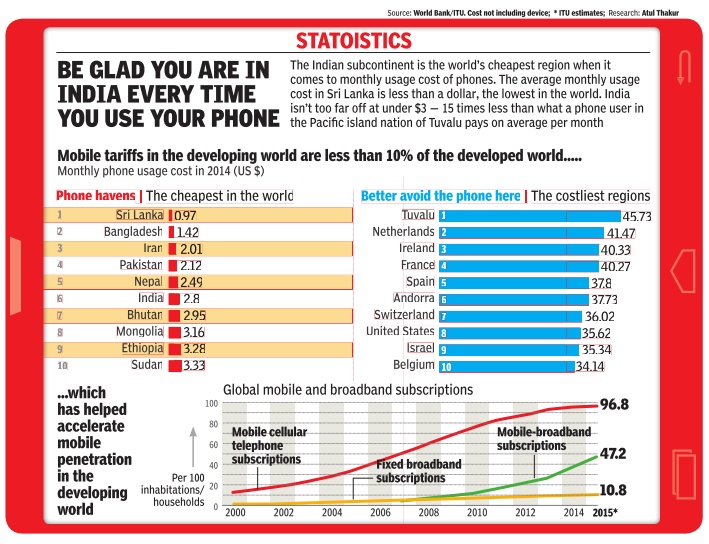

Towers and the law
SC shuts down tower because man claims it gave him cancer
First In Country To Be Closed On Individual's Plea
A 42-year-old domestic help will go down in history as the man who persuaded the Supreme Court to shut down a mobile phone tower on the ground that its electromagnetic radiation afflicted him with cancer.
Last year, Harish Chand Tiwari, who works at the residence of Prakash Sharma in the Dal Bazar area of Gwalior, moved the SC through advocate Nivedita Sharma, complaining that a BSNL tower illegally installed on a neighbour's rooftop in 2002 had exposed him to harmful radiation 24x7 for the last 14 years.
The order is likely to fur ther fuel the debate over the effects of radiation from mobile phone towers with a section of activists feeling vindicated while the government argues there is no evidence to prove that the waves cause cancer.
Radiation from the BSNL tower, less than 50 metres from the house where he worked, afflicted him with Hodgkin's Lymphoma caused by continuo us and prolonged exposure to radiation, Tiwari complained.
In a recent order, a bench of Justices Ranjan Gogoi and Navin Sinha said, “We direct that the particular mobile tower shall be deactivated by BSNL within seven days from today .“
The tower will be the first to be closed on an individual's petition alleging harmful radiation. The SC, which began he aring the issue relating to radiation from cell towers from March 18 last year, had asked the parties to file additional documents to show that radiation from such towers were harmful to humans and animals. Private petitioners have been predicting disastrous consequences in the future. Activists have alleged that radiation from mushrooming mobile phone towers have caused sparrows, crows and bees to vanish. But the Cellular Operators Association of India and the Union government have vehemently denied the allegations and said such fears were unfounded and that no scientific study had conclusively linked mobile phone tower radiation to cancer or vanishing of sparrows, crows and bees.
The department of telecom (DoT) in its affidavit before the SC in October last year had said that of the over 12 lakh mobile phone towers in the country , it had tested 3.30 lakh towers. It said only 212 towers were found exceeding radiation limits and they were fined Rs 10 lakh. It said so far Rs 10 crore was collect ed from different cellular op erators as penalty .
DoT had relied upon a World Health Organisation (WHO) report as well as over 25,000 articles in the past 30 years to say that there was no confirmation of “any health consequences from exposure to low level electro magnetic fields“.
In 2014, a parliamentary committee had recom mended to the Union government to carry out a scientific study by a reputed govern ment agency on im pact of telecommunication and mobile phone towers and handsets on humans. Private petitioners had alleged that no such study had been un dertaken. But the DoT had informed the court that the Centre had constituted an expert committee to study the possible impact of elec tromagnetic field radiation on living beings.
See also
Telecommunications, India: 1
